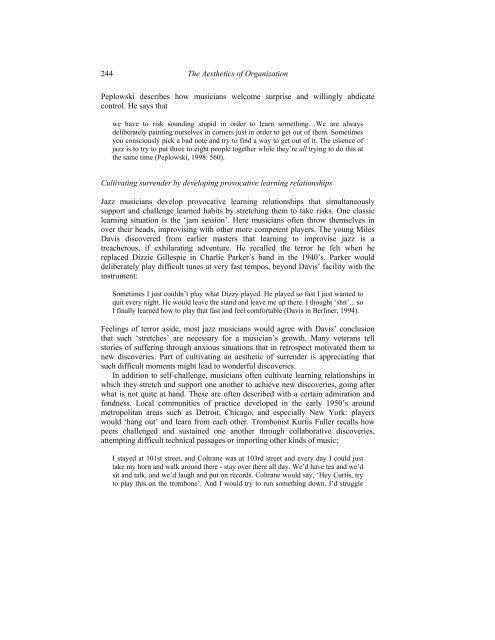Cultivating aesthetics - iSites
Cultivating aesthetics - iSites
Cultivating aesthetics - iSites
Create successful ePaper yourself
Turn your PDF publications into a flip-book with our unique Google optimized e-Paper software.
244<br />
The Aesthetics of Organization<br />
Peplowski describes how musicians welcome surprise and willingly abdicate<br />
control. He says that<br />
we have to risk sounding stupid in order to learn something…We are always<br />
deliberately painting ourselves in corners just in order to get out of them. Sometimes<br />
you consciously pick a bad note and try to find a way to get out of it. The essence of<br />
jazz is to try to put three to eight people together while they’re all trying to do this at<br />
the same time (Peplowski, 1998: 560).<br />
<strong>Cultivating</strong> surrender by developing provocative learning relationships<br />
Jazz musicians develop provocative learning relationships that simultaneously<br />
support and challenge learned habits by stretching them to take risks. One classic<br />
learning situation is the ‘jam session’. Here musicians often throw themselves in<br />
over their heads, improvising with other more competent players. The young Miles<br />
Davis discovered from earlier masters that learning to improvise jazz is a<br />
treacherous, if exhilarating adventure. He recalled the terror he felt when he<br />
replaced Dizzie Gillespie in Charlie Parker’s band in the 1940’s. Parker would<br />
deliberately play difficult tunes at very fast tempos, beyond Davis’ facility with the<br />
instrument:<br />
Sometimes I just couldn’t play what Dizzy played. He played so fast I just wanted to<br />
quit every night. He would leave the stand and leave me up there. I thought ‘shit’... so<br />
I finally learned how to play that fast and feel comfortable (Davis in Berliner, 1994).<br />
Feelings of terror aside, most jazz musicians would agree with Davis’ conclusion<br />
that such ‘stretches’ are necessary for a musician’s growth. Many veterans tell<br />
stories of suffering through anxious situations that in retrospect motivated them to<br />
new discoveries. Part of cultivating an aesthetic of surrender is appreciating that<br />
such difficult moments might lead to wonderful discoveries.<br />
In addition to self-challenge, musicians often cultivate learning relationships in<br />
which they stretch and support one another to achieve new discoveries, going after<br />
what is not quite at hand. These are often described with a certain admiration and<br />
fondness. Local communities of practice developed in the early 1950’s around<br />
metropolitan areas such as Detroit, Chicago, and especially New York: players<br />
would ‘hang out’ and learn from each other. Trombonist Kurtis Fuller recalls how<br />
peers challenged and sustained one another through collaborative discoveries,<br />
attempting difficult technical passages or importing other kinds of music:<br />
I stayed at 101st street, and Coltrane was at 103rd street and every day I could just<br />
take my horn and walk around there - stay over there all day. We’d have tea and we’d<br />
sit and talk, and we’d laugh and put on records. Coltrane would say, ‘Hey Curtis, try<br />
to play this on the trombone’. And I would try to run something down. I’d struggle
















